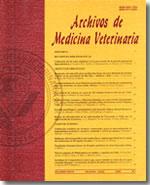Exercise-induced pulmonary hemorrhage in horses: a review
Main Article Content
Abstract
Exercise-induced pulmonary hemorrhage (EIPH) is as mayor cause of poor performance in the equine athlete. It is an important cause of exercise intolerance and results from strenuous exercise and pathophysiological changes in the equine lung and possibly in the airways. Endoscopic surveys of the respiratory tract of horses after competitive events have shown that many horses experience EIPH, but only a relativity small percentage shows blood at the nostrils. The reported incidence of EIPH in different breeds varies between 40-85 percent. The cause of bleeding in exercising horses has had considerable debate over the past three centuries, but currently the most accepted hypothesis is that the source of hemorrhage is due to the lungs capillary disruption during exercise. This capillary disruption increases with increasing vascular transmural pressure during exercise. Many therapeutic regimens have been suggested; but there have been few studies performed to evaluate the efficacy of these treatments. Furosemide is the most widely used medication for the treatment and prevention of EIPH, due to its ability to attenuate the exercise induced increase in right atrial, pulmonary arterial and pulmonary capillary pressure. The hemodynamic effect of furosemide is mediated by a reduction in plasma and blood volume.
The purpose of this review is to give an up-date on the etiology, clinical signs, physiophathology, diagnosis and treatment of EIPH.

